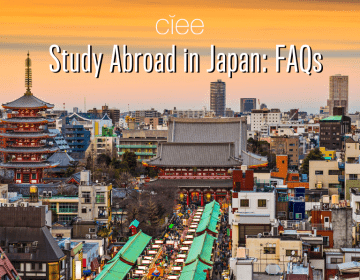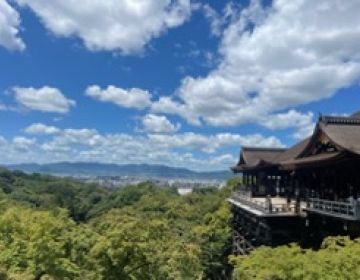AMJ Adventures ― Hiroshima Part1
Authored by Thalo Campbell
初めまして、皆さん~。Hello everyone, I’m Thalo Campbell. I’m in the Spring Ancient and Modern Japan (AMJ) program here at CIEE Kyoto, although by the time this is posted I’ll likely be back in the US! As part of the AMJ program we went on numerous trips to locations and experiences that helped us learn about Japanese culture and history. The overnight trip for our program was to Hiroshima, but it stands out as a destination beyond that.
I trust that no one reading this will be blindsided by the importance of Hiroshima. During World War 2 Hiroshima, along with Nagasaki, were completely decimated by the dropping of Atomic Bombs by the US military. US school history classes occasionally hold debates on whether or not the dropping of the bombs was justified, but going to Hiroshima myself taught me a lot about the aftermath of the bombing – something that wasn’t very focused on in mine nor anyone else’s (in the AMJ program) school classes. Upon returning from Hiroshima, we talked about it in our history classes, I ended up comparing it to Holocaust education. When we learn about the Holocaust in US schools, we focus on the horrors in an attempt to drive home why something like it should never happen again. There isn’t similar focus given to the aftermath in Hiroshima or Nagasaki, despite similar arguments of ‘this should never happen again’ we don’t go out of our way to show why. The US doesn’t want to teach about its own failures, which is understandable to a point, but especially in the context of nuclear threats from North Korea it is a reality that needs to be discussed.


We arrived in Hiroshima on the Shinkansen and managed to leave our bags at the hotel before we walked to the Peace Park. The Peace Park in Hiroshima is the former downtown area of Hiroshima. Nothing is there but modern buildings, memorials, and trees anymore. The hypocenter – the location on the ground directly underneath where the bomb detonated – is located within former downtown Hiroshima. I have visited the museum for the Manhattan Project in Oak Ridge Tennessee and the museum here in Hiroshima was a stark contrast. While the Oak Ridge Manhattan Project Museum focused on the development of the bomb and the scientific advancements it spawned, the Hiroshima Peace Museum allocated a single exhibit to these topics. The majority of the museum focused on the bombing itself, the lives of the survivors, the history of Hiroshima and subsequent peace efforts that have been centered in Hiroshima or advocated for by survivors. The survivors of the atomic bombings call themselves hibakusha. The term “hibaku” was coined after the bombing to refer to being exposed (被, hi) to radiation from the bomb (爆, baku). The ‘sha’ (者) ending denotes the term as referring to a person, so hibakusha literally means ‘a person who was exposed to the Atomic Bomb’. It has come to refer to the dwindling number of survivors including adults, children, neo-natal survivors, and victims of the radioactive rain caused by the bombings.

The Hiroshima Peace Museum featured an exhibit on children survivors when we went. During WW2, Japan was mobilizing their entire country to the war effort. With the fire bombings in Tokyo, it was a valid concern that Hiroshima – the headquarters of the Imperial Army – would be similarly targeted. High school girls were mobilized to become radio operators, high school boys into the army itself, and middle and elementary school students were creating fire breaks in the dense Hiroshima downtown. No one from downtown Hiroshima survived the bombing. Hundreds of elementary school students were evaporated instantly. The accounts from survivors featured in the Peace Museum were littered with survivors guilt. Every last one of them had stayed home from school for some reason, they were sick, not fit for the manual labor of fire break creation, and because of that they outlived the majority of their friends.
The later exhibits focused on the direct aftermath of the bombing. One exhibit that everyone agreed stabbed you in the heart was the section of drawings. A photographer in Hiroshima during the bombing was able to take two photos on Miyuki bridge. Matsushige, the photographer, describes his hands as shaking so badly, in shock of the scene as he was, that he was only able to click the shutter twice. These are the only photographic records we have of the direct aftermath of the bombing, but in 2002 the Peace Museum called for hibakusha to submit drawings of their experiences in the aftermath or of Hiroshima before the bombing. The section on drawings in the Peace Museum at the time I went, featured childish, unskilled drawings of the artist’s experience in the direct aftermath of the bombing. It is one thing to read or hear a description of how skin was flaking off people, burns covering their entire body as their clothes melted, how the river was crowded with corpses to the point you might have been able to walk across it. Seeing these horrors depicted before you in shaky colored pencil or marker, is an entirely different experience. The emotion conveyed by not only the images but the way such hobbyist drawings starkly depict the reality of the aftermath strikes you hard. I don’t have any better description for it, for all that those words seem insufficient. Unfortunately, the museum did not allow photos, but a google search or looking at the Hiroshima Peace Museum website will provide some examples.
After the museum visit, we had the honor of meeting and speaking with a surviving hibakusha. I will be honest, I broke down crying and missed quite a bit of Horie-san’s presentation. Soh Horie survived the bombing from the rural area outside of Hiroshima city, his father was not so lucky. Horie-san’s father was working in an office building when the bomb detonated, and the building caught on fire. Horie-san told us that because his father had Judo training, he was able to leap out of the window and make his way back to their house. However, his father was burdened greatly by the guilt that he was the only one able to get out for his remaining days of life. Horie-san’s mother and sister both suffered from leukemia and other cancers, Horie-san himself went through two different bouts of leukemia. Because their house was one of the only ones left standing, it became a makeshift evacuation center, and the floors were lined with exposed victims moaning and crying for water. They could not give them water. At the time, so soon after the bombing, people didn’t know why victims couldn’t be given water, just that it would kill them. But later investigation showed that because people’s insides were so deteriorated by the radiation exposure, the water ripped up the lining of their organs and killed them. Water poured on outer burns also caused the body to go into shock, this is why the river was filled with bodies. When people fled there in attempts to relieve the pain of the burns they went into shock and drowned. In the photographs taken in the aftermath by Mitsushige, the people on the bridge are actually being treated with cooking oil because water would harm them and they had no other first aid supplies.
Horie-san, like many other hibakusha, is an advocate against nuclear power in Japan. He spoke to us about his current activism project, which was his opposition to the creation of a nuclear power plant on Shikoku across from Hiroshima – directly on a fault line. He talked to us about how hibakusha stepped up to advocate against nuclear power in the aftermath of the Fukushima incident and pointed out how a similar meltdown at the proposed reactor would affect Hiroshima.

The next day of our trip to Hiroshima, we actually left Hiroshima to visit Itsukushima and Miyajima. However, before we left, I decided to explore the Peace Park and Hiroshima Castle. I was early enough to the park that I couldn’t ring the peace bell, it wasn’t allowed until after 9am, but I got to hear the peace prayer from the Clock Tower of Peace. The atomic bomb was dropped in Hiroshima on August 6th at 8:15 am and every day the clock plays a musical prayer at the same time.
There were countless other memorials in the park, all with strands of colorful paper cranes and even bottles of water left as offerings.
[to be continued]
Related Posts
Study Abroad in Japan: FAQs
If you’re about to embark on a study abroad adventure to Japan or considering this fascinating country a study abroad option, read on as we dive into some of our... keep reading
Temples, Shrines, Festivals, and Kyoto!
Hi, I’m Daniella (or Dani), and I participated in the CIEE Kyoto Summer Ancient + Modern Japan 2023 program! Living right outside of Los Angeles, my knowledge of Japanese culture... keep reading





